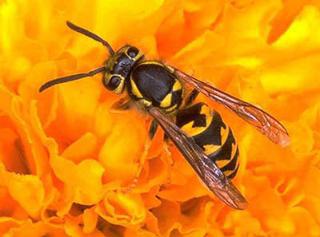Smooth, tiny and winged – yellow jackets tend to make people recoil and in some cases scream.
Orcas Islander Gerry Ellis describes the number of yellow jackets at her home this year as a “bazillion that has diminished to about a million since putting out half a dozen yellow cone plastic traps [complete with ‘bug’ bait inside]. They swarm and fight to be the first to get into their yellow coffin.”
Yellow jackets are about one half-inch long and appear short and stocky. Paper wasps are up to three fourths of an inch long, and are more slender.
According to Russel Barsh, director of the Lopez-based nonprofit laboratory Kwiaht, there are at least seven species of wasps in the Northwest, including native and introduced European and Western yellow jackets, bald-faced hornets and paper wasps.
On Orcas this summer, islanders are wondering if there is an influx of these yellow and black insects?
Barsh said that the weather in spring is one way to determine an abundance of yellow jackets or wasps. A cool wet spring decreases wasp populations because it reduces the survival of the previous year’s queens, which must spend winter in a tree cavity, under a log, or in a wood-pile until the weather is warm enough for them to emerge, hunt and start laying eggs, he said.
“But cool wet springs can also be bad for many of the animals and parasites that eat wasps, so it’s not quite that simple,” he added. “Everything goes in interlocking cycles.”
According to “Yellow Jackets and Paper Wasps” by WSU entomologists Arthur L. Antonelli and Roger Akre, in the late summer-early fall, worker yellow jacket populations and their colonies are at their peak. Then the colony begins to decline, and their deserted nests disintegrate rapidly in winter.
Antonelli and Akre wrote that maximum population size is attained in August or September.
Their article stated that although most people consider these winged creatures to be pests, we may not want to see a dimished population because of the benefits they provide.
“Yellow jackets and paper wasps feed their young numerous insects that ordinarily damage shade trees and crops,” wrote Antonelli and Akre. “They also kill countless houseflies and blow flies. Yellow jackets and paper wasps scavenge for meat and sweets and can become pests, especially at picnics and campgrounds.”
Wasps also eat large quantities of garden pests including aphids, beetle larvae, moth larvae cutworms and inchworms, Barsh said, but they also eat pollinators including honeybees, and flower flies, as well as other useful insect-controllers such as spiders.
To control populations of waps, he recommends removing paper wasp nests, characterized by having open combs with cells. Nests that are close to doors, windows and patios should be the highest priority. Always remove nests at night when the insects are home and dormant and as soon as they appear in the early summer, he added.
Antonelli and Akre recommend if you are allergic to wasp stings, do not risk removing the nest yourself.
“Some people react strongly to the stings of bees and wasps,” they wrote. “Symptoms can include swelling, nausea, dizziness, difficulty with breathing, and shock. Symptoms may be immediate or delayed for several hours. For most people without allergies, a sting may be no more than a minor annoyance or irritation.”
As for the popular yellow cone traps you can purchase, Barsh said they kill lots of wasps, but the colonies will likely survive.
“Avoid chemicals – knockdown sprays use extremely toxic and persistent chemicals that kill all insects including bees,” he said.
Yellow jackets and paper wasps do not reuse their nests the following year, although paper wasps may construct a new nest adjacent to an old one, according to Antonelli and Akre. If you choose to leave the wasps alone, the nest will usually disintegrate over the winter months.
According to Barsh most yellow jackets are also “naturally controlled” by other wasps, mites, and bacterial, viral and fungal infections.
“By far the best advice is: don’t get near a nest, don’t look or smell like a flower,” he said. “And if you want to dine al fresco during the summer months, leave a few traps out around the patio or garden area you’d like to use,” he said.
For more information, read “Yellow Jackets and Paper Wasps” by Akre amd Antonelli athttp://cru.cahe.wsu.edu/CEPublications/eb0643/eb0643.pdf.



